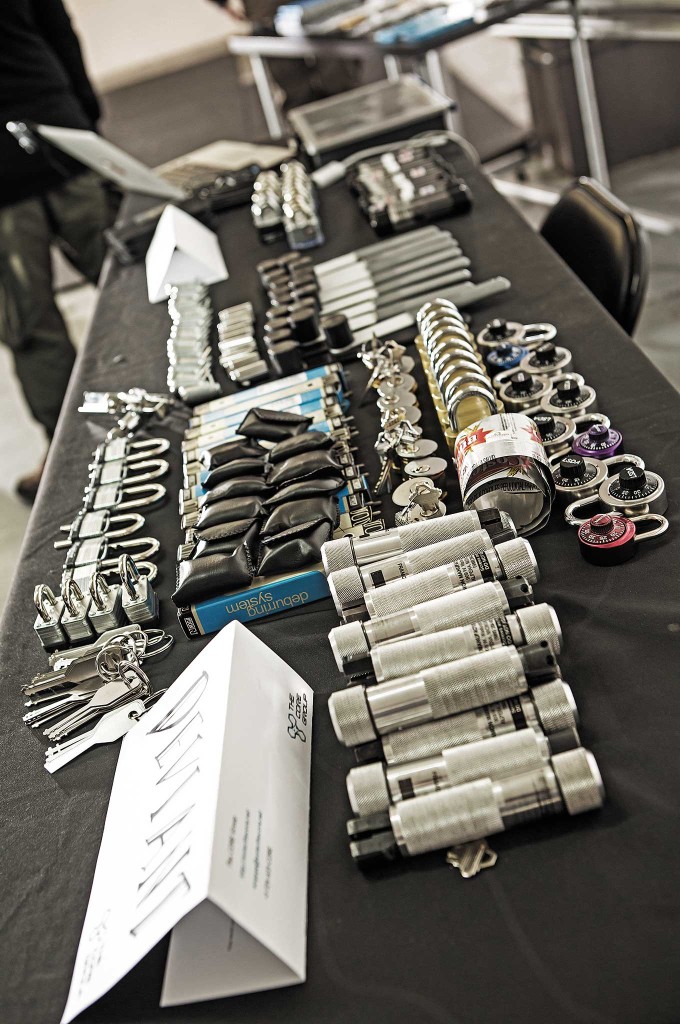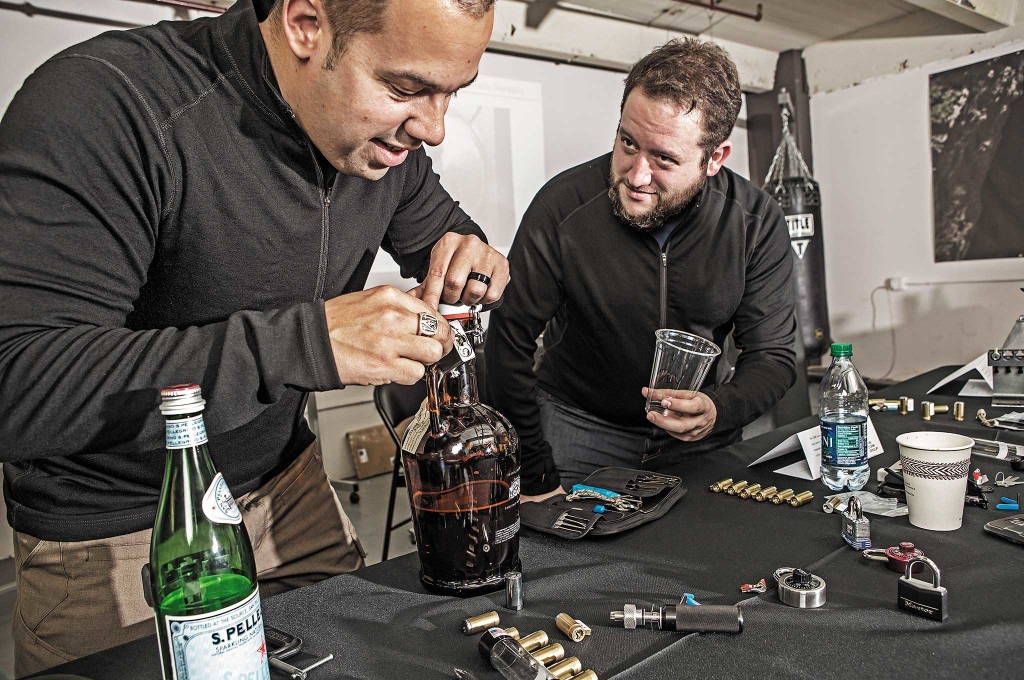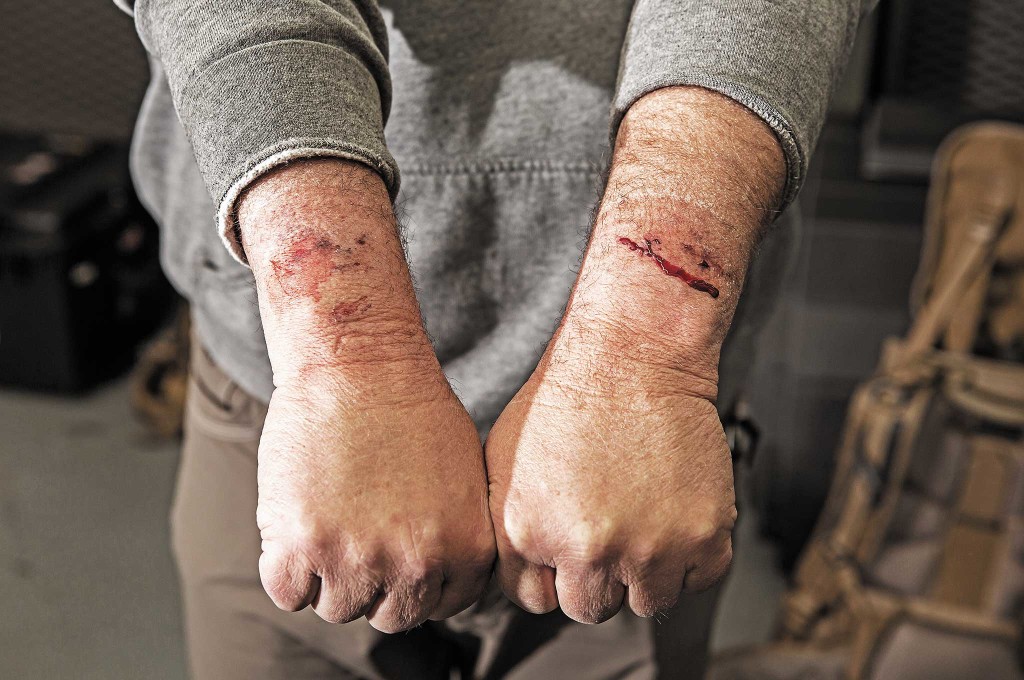Offgrid Preparation How to Strengthen Your Defenses – The Master Key
In This Article
Photos by Q Concepts
WARNING!
The concepts shown here are for illustrative purposes only and not an endorsement for breaking and entering, which is a crime. Do not lock-pick without permission. Seek a reputable instructor for more information.
Bugging out is all the rage. There's bug-out gear for your bug-out bag all ready to be thrown into your bug-out vehicle. Bugging out sounds cool and sexy, but for the majority of people and situations, bugging out is Plan B. Blizzard? Drought? An EMP hit? Or terrorist attack in another part of the country? Yep, bugging in. Even when bugging out is necessary, it may not be possible. The roads may be clogged, your car's electronics might be fried, or a loved one or member of your survival group is injured and can't be moved.

Whenever sheltering-in-place, security of your residence or compound is paramount. Your home provides safety and stores your supplies. (See our Spring 2014 issue for “Household Survival,” a feature on emergency uses for commonplace items.) Sure, you have locks, a dog, and maybe even an alarm (if you're lucky enough to have electricity), but how easy are these systems to bypass? And how can you harden your security before, during, and after SHTF?
The best way to beef up your security system is to defeat it. That's where The CORE Group comes in.
In an OG exclusive, we attended the CORE Group's Covert Entry Concepts class hosted by Triple Aught Design (TAD). Held in San Francisco at TAD's headquarters, the CORE cadre provided hands-on instruction geared toward teaching the strengths and vulnerabilities of physical security solutions; how they are attacked and even bypassed completely. Students received a thorough understanding of the underlying mechanisms, including the tools and techniques, used to manipulate physical security barriers. We learned everything from picking common locks to improving defensive security at home and work.
According to our master-key mentors, Robert Pingor and Deviant Ollam, once you understand how locks and other security measures are breached (oftentimes easily and quickly), you will have the knowledge to harden the defenses in your daily life. After three days of mind-blowing fun, we bring you four key lessons we learned about protecting our home and the precious treasures inside.

Not all class time was spent sitting on our rear ends. Getting cuffed, thrown into the rear end of a car, and...
In the story Ali Baba and the 40 Thieves (from One Thousand and One Nights) the thieves believed their stolen loot was completely safe because of a magic seal. Our hero, Ali Baba, overheard the secret of opening the magical cave. One simply had to say, “open sesame” and the magical cave would open up and divulge its treasures. This magic “lock” appeared impenetrable, yet a simple phrase opened it.
The same holds true with our home. The majority of us rely on locks to keep our families safe on the inside, and keep the bad guys on the outside. The locks on our doors and windows are simply illusions of security because, after just a couple of hours of instruction, we were able to pick common tumbler locks (found on most doors and padlocks) with simple tools anyone can buy online.
Lock picking is a skill that is easy to, ahem, pick up. Not only are the tools available online, but there are also videos and blogs online on how to pick all manner of locks. A search on YouTube revealed approximately 143,000 results for “lock picking.”

Gears of Door: All equipment to practice lock picking were supplied and participants went home with high-quality...
Besides picking, another method of opening locks is called bumping (which has received a lot of press). Bumping involves a hammer and a special (yet readily available) bump key. Insert the bump key into the keyway, twist the key slightly, add a simple whack of the hammer, and voila — open sesame. The solution? Upgrade locks to pick- and bump-resistant ones. The resistant locks cost more, but have special mechanisms that make picking and bumping more difficult. This will deter less experienced lock pickers and slow down the more experienced ones. Getting ready for the apocalypse is expensive, so you might be tempted to skip on the better locks for a state-of-the-art power generator or the latest-and-greatest backpack. But what good are those items if marauders have defeated your dead bolts and can forcible take them at will? Upgrading locks and dead bolts is a wise investment for protecting you, your family, and your supplies.
Something else to consider when you're upgrading your locks is to look at the hinges on the exterior doors. If the hinges are on the outside, you have a problem. A burglar can simply remove the pins with very little skill and open the door. If you can't alter the hinges, change them to ones with non-removable pins.
Front and back door locks are a good place to start, and layering your security will make thieves and looters look for an easier mark. Pingor states that, “each layer of security serves to deter or delay.” Think of your home as a fortress with concentric rings of security, like an onion. The more layers of defense and security, the better the protection. The closer to the center, the more complex the security system should become.
How many layers do you need? Pingor asks, “What is it you're trying to protect?” The more valuable your possessions, the more you want to spend. And, during a collapse of law and order, “valuables” could be your life and those of your loved ones.
So, here are some security layers to consider:
Community: Neighbors can be the first layer of defense. “DBAA rules apply here,” Ollam warns, referencing the Breaking Bad imperative of “Don't be an a-hole.” Be friendly and get to know those who live around you. Join the neighborhood watch or start one if you need to. Strength comes in numbers. There may be a doctor, nurse, police officer, or urban survival magazine editor just a few homes away. Getting help and support from the people around you will be critical when anarchy abounds. You never know what kind of skillsets are in your immediate surroundings unless you get out there and socialize. Neighbors looking out for each other act as the first layer in a security system.
De-Fence: The next layer is on the perimeter of your property. A fence can serve the purpose of defining your borders and keeping four-legged animals out. The two-legged variety will have a much easier time getting through. All barriers can be breached, and fences are often easily bypassed by humans. Regardless, having a fence is better than not. And if you're blessed to not have a homeowner's association, adding barbwire or electricity can be another layer of defense added to de fence (pun intended).
K9 Alert System: A guard dog can act as both a deterrent and an alarm. Your landlord doesn't allow dogs or you're allergic to canines? Put up a “beware of dog” sign and get a dog bowl to put outside. Make sure to buy the big kind, because a small 7-inch bowl for a Chihuahua will likely not strike terror in the heart of a potential intruder.
Security Alarm: Lights, camera, action! Count your lucky stars if electricity is still up during a crisis. If it is, having lights, cameras, and alarms around your compound is a big plus. Cockroaches and thieves hate the light, so have plenty of outdoor lighting. Afraid of a power outage? Solar-powered LEDs make sense for when the grid does go down. Installing security cameras will allow for monitoring of several areas from one location. CCTVs are now more affordable and can be monitored from a smartphone. Alarm systems can add another layer of early warning and help deter intruders. Be sure to place the alarm signs in obvious locations.
Window Shopping: Windows present a major security risk. While they allow us to see who's out there, they also let bad guys see inside. Plus, they're usually made of thin panes of glass. So be sure to review our Winter 2014 issue for the article titled “Securing Your Weakest Link” about how to fortify your windows against man and nature.
Arm the Safe (Room): Inside, equip your safe room with a solid-core door with a lock, a spare car remote if your car is close (so you can hit the panic button), some type of weapon (like a firearm, knife, pepper spray, etc.), a good flashlight, and a cell phone with charger.
What about valuables? Thieves know that the good stuff is often in the master bedroom and closet. Pingor recommends placing valuables in a shoebox, which goes in your kid's closet.
Yes, and to forgive, divine. Unfortunately, the only thing divine about errors during a SHTF scenario is meeting our maker. Having layers of security is useless once human error is introduced. “Having a $3-million security system is no good if you have a bad person monitoring it,” Pingor cautions. Humans are hardwired for errors, and Robert gives us examples.
Creatures of Habit: People typically have predictable patterns. According to Robert, humans are 93-percent predictable in regards to patterns of movement. As creatures of habit, we are reluctant to change these patterns and seldom deviate from our schedules. Once known, schedules can be exploited. Leaving our home, compound, or shelter at routine and predictable times leaves weaknesses in our security. Going to work, church, or gym consistently on the same days, times, and routes, creates predictability that bad guys can capitalize on. Leaving our EDC items such as keys and weapons in the same places creates vulnerabilities. Repetitive schedules and routes of guards or lookouts can also be exploited for attack.
Generally Lazy: Security SOPs and protocols may be abandoned in favor of convenience. Being lackadaisical by not locking the door or turning on the security system will make these systems useless. And what about monitoring the CCTV? According to Pingor, “You can watch four monitors for 12 minutes before you lose it.”
Multitasking: We can only do one thing well at a time. Studies show, the more tasks we try to perform at one time, the less efficient we are, and the more prone we are to making mistakes. It's difficult if the person in charge of security has to monitor the cameras and cook at the same time. The result will most likely be poor security and a burnt meal.

Security experts Robert Pingor and Deviant Ollam (right) establish that class is clearly not all work and no play.
Not Observant: This one goes hand in hand with laziness. Just look around next time you go shopping and you will notice that situational awareness is rare in the general population. In public, most people keep their heads down and, as of late, eyes glued to their phones. Even when looking around, people are generally not aware.
The Solution: Take the creatures-of-habit error and leverage that into something useful. Make it a habit of locking doors, turning on alarms, focusing on a single task, being observant, and changing your schedule and routes (whenever you can). Correcting these mistakes is easier said than done — you can't exactly pick up your daughter from school two hours later than normal due to a change in “security protocols.” But in the long run it's worth the effort.
We spend a large part of our life at work and blindly leave issues of security to management. With mass shootings making headlines, taking a hard look at the security at the office makes sense. It doesn't matter where you work (a school, movie theater, building, or small business), paying attention to the strengths and weaknesses in security protocols may save your life when a crisis unfolds.

Breaking free of duct tape is easier than you think…but not without consequence. Simply raise your fists above...
Consider the following next time you enter your workplace and keep in mind the weaknesses of human error, discussed previously.
The Solution: Start with this list and if you see major flaws, address it with management. If nothing will or can be done, take it upon yourself to create a safety plan.
As a prepper, taking courses from legitimate sources like the CORE Group at Triple Aught Design is highly recommended. Learning something useful, making friends and getting off the couch makes us happy. A week after the class, we're still smiling like a kid on Christmas morning every time we pick open our suitcase padlock. More importantly, though, is our changed outlook on home and work security.
During disasters like Hurricane Katrina or the L.A. riots, lawlessness was rampant. Effective security measures will help keep the bad guys out. No matter if you bug-out or decide to shelter in place (at work or home), plugging the holes in your security systems can save your life.
Robert Pingor, chief of The CORE Group's Law Enforcement Division, has extensive training in both the government and private sectors. His policing and operations background was honed during his years at the National Security Agency, where he served with distinction in four different specialty units. He has instructed for countless military law enforcement agencies — from the State Department and the National Defense University to the U.S. Air Force and the U.S. Naval Academy. Additionally, he regularly conducts trainings for Black Hat, the SANS Institute, and other technical conferences.
While paying the bills as a security auditor and penetration testing consultant with The CORE Group, Deviant Ollam is also a member of the board of directors of the U.S. division of TOOOL (The Open Organisation of Lockpickers). Every year at the hacking conventions DEFCON and ShmooCon, Deviant runs the Lockpick Village. He has conducted physical security training sessions for a wide range of organizations, from the FBI and DARPA to Black Hat and DeepSec.
Myth #1: I Only Need the Pick: In 2011's Tower Heist, a petty thief (played by Eddie Murphy) teaches Ben Stiller's group of misfits how to pick a lock. He hands everyone a bobby pin and tells them, “Earlier today I taught you all how to pick a lock with a bobby pin. I want y'all to practice on this door.” In the real world, Ben and his crew can practice all day and not open the lock with only a bobby pin. Hollywood often portrays opening locks with just a pick tool (commonly fabricated from a bobby pin, paper clip, or sunglasses). The bobby pin in this movie can be jimmied to act as a pick that pushes up the pins inside the lock, but there needs to be a second tool, called the turning tool. This tool (sometimes mislabeled a tension wrench) allows for the binding of the pins and the turning of the plug.
Myth #2: Pick-Proof Locks: All locks can be picked with enough time and the right amount of skill. Nothing is pick-proof. Still, the pick-resistant and bump-proof locks are worth the investment. According to Pingor, if the lock was able to delay the picker or force them to use a different attack (like breaking a window), the lock did its job.
Myth #3: I Can Practice on My Front Door: There are two golden rules of lock picking: do not pick any lock without the owner's permission and do not pick any locks in use. If the lock is used for security purposes (like the front door), do not pick it unless absolutely necessary. Picking locks can wear out the pins, or even render them inoperable, and you do not want this happening to any doors in use.
Myth #4: My Locks are Modern: The new lock on the door or filing cabinet may have a nice shiny sheen, but the basic mechanism inside dates back to 4000 B.C. in Egypt. The modern pin tumbler lock with double pins was awarded a patent way back in 1805. Found in doors and padlocks, the pin tumbler mechanism is the most common worldwide. The wafer tumbler lock is another mechanism. Utilized in filing cabinets, display cases, and cars, the wafer tumbler lock is the second most common mechanism in locks. It was patented in 1868, and people have been working to defeat them ever since.
The CORE Group – www.enterthecore.net
Triple Aught Design – www.tripleaughtdesign.com
 STAY SAFE: Download a Free copy of the OFFGRID Outbreak Issue
STAY SAFE: Download a Free copy of the OFFGRID Outbreak Issue
No Comments